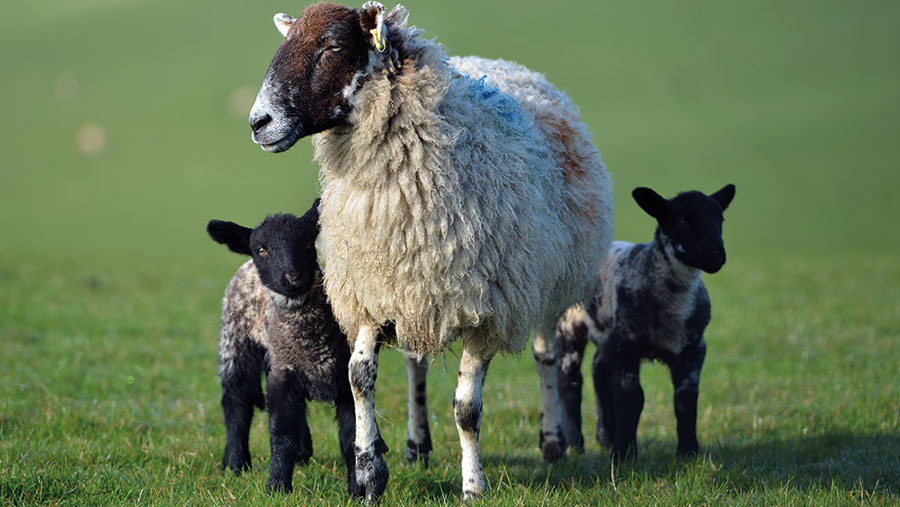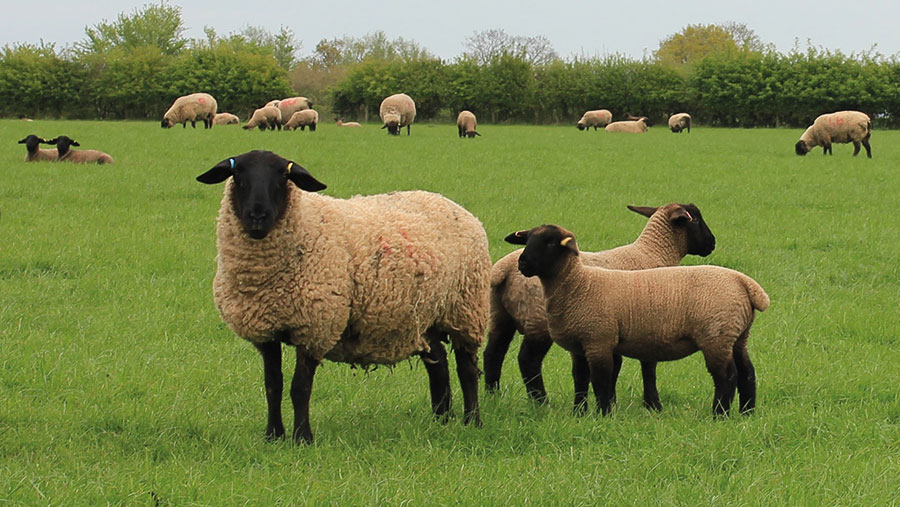Profitability peaks with 55-65kg lowland ewe, study shows
 © Peter Cripps/Adobe Stock
© Peter Cripps/Adobe Stock Commercial lowland sheep are too big, pushing up maintenance costs and hampering profitability.
This is according to Tim Byrne of science and technology consulting firm Abacus Bio, which conducted a modelled study that evaluated breeding female mature weight on farm.
See also: Trial finds ewe data is route to bigger lamb cheque
Speaking to producers from across Europe at the Sheep Breeders Roundtable (held in Derby, 11-13 November), Dr Byrne said an average ewe at 55kg is optimum, and the most profitable ewes could weigh 55-65kg.
All costs were accounted for in the model, including the impact of changes in maintenance cost, lamb cheque and cull ewe value on a 100-ewe flock.
Monitor maintenance cost
Perthshire-based farm adviser Emily Grant of Forrit Consultancy told Farmers Weekly 400 70kg ewes would have the same dry matter (DM) intake as 500 ewes weighing 55kg.
“Farms have shown they can increase output by running smaller ewes,” said Mrs Grant. “But the challenge is the extra, smaller lambs, [which] shift grassland demand later in the season, as they take longer to hit slaughter weight.”
She suggested a 55kg ewe might be too light for a lowland ewe, given that quickly reaching slaughter weight (typically 42kg) was critical for a cost-effective system.
She added: “Ideally, your system will sell all lambs before tupping, so ewes can winter on grass, and you can graze for a good scan, rather than feed for a good scan.”
Combining rotational grazing with a moderate ewe size produced a “big win” of increased pasture production from the same area of land.
“Biggest gains are from shortening [grazing periods] from four-to-seven days to one-to-two days and getting the best utilisation of grass.”
How to review your ewe type
- Look at kg output/ha: This metric is often a driver of profit, but you must ask yourself whether this is being supported by expensive inputs such as fertiliser or concentrate feed
- Is high production returning you a margin? A ewe may have a hugely productive five months, but what is the cost of the unproductive seven months?
- What is an optimal scan? Scanning at 190-200% often means lots of triplets, and triplets see higher mortality after supplementary feed cost. Indoors, a scan of 180-185% might be optimal, whereas outdoors, a scan of 170-175% might be best.
Bigger sheep suit some systems
Derek Hall, Lilyburn, Penicuik, breeds Mules and Bluefaced Leicesters, which he says sell well because of the size and milkiness of the resultant Mule ewes.
Mr Hall told Farmers Weekly that priorities vary across systems vary across systems and parts of the country, but the “holy grail” for many was a ewe that produced two 20kg carcasses by 12 weeks.
“This year, we saw the benefit of having bigger lambs,” he said. “An extra 4kg was worth £15 and not just the value of the extra kilos, due to the lack of heavy lambs.”
He made the following points:
- The research was based on a model – real-farm experience may be different in practice
- Previous work by the Meat and Livestock Commission showed the weight at which a lamb would reach an R3L was half the average of its parents’ mature weight
- If 75kg ewes were stocked at 10 ewes/ha, scanned at 180% and reared 170% in a system combining indoor and outdoor lambing, and produced 45kg lambs, this would amount to 17x45kg = 765kg liveweight/ha
- A 63kg ewe would have to scan, rear and milk exceptionally well to match this performance
- Days to slaughter was key for methane emissions.
Grass-based switch takes 10kg off ewes

© Bentley Suffolks
A transformation of grassland performance on a Warwickshire farm has taken 10-15kg off the ewe mature weight of a leading pedigree Suffolk flock.
Since 2010, the Harding family, at Lodge Farm near Nuneaton, has transitioned from a creep-fed, early lambing system to one based on an animal’s ability to maintain body condition and produce lambs off grass.
This has cut mature ewe weight from 110kg to 90-95kg.
Rams are now sold off farm with no creep at all. The flock sold 242 shearling rams this year, which was nearly 100 more than two years ago.
Feeding rams with concentrate meant they did not last long enough for customers, even though the rams were high index and bred good prime lambs.
Buyers that produce Suffolk Mules have had great experiences with the new commercially bred tups, according to the family.
It was feared the lighter and smaller-headed tup would not suit some buyers.
Moderating sheep size drives profit
Matt Harding, who farms with parents Charles and Jan, and wife Ellie, and spoke at this year’s Sheep Breeders Roundtable, believes moderating sheep size drives profit and increases output/ha at home and for customers.
“Mature ewe size is lower, and I believe that is because we have selected for sheep that maintain condition on a grass-based system, so the amount of forage eaten to satisfy maintenance requirements is lower on smaller sheep,” Mr Harding said.
Farm facts: Lodge Farm
- 180 Suffolks (92-95kg)
- 170 Aberblacks (80-85kg)
- 120 Aberfields (70kg)
- 72.8ha (180 acres) owned
- 20ha (50 acres) rented
- 100ha (247 acres) arable cover crops grazed from December to late March
- Lowland grassland on clay and loam soil
He added: “I could probably run 120 Aberfields and their lambs, which are 70kg at mature weight, compared with 100 Suffolks and their lambs, which are 91kg this year. So, it’s a 20% increase in stocking rate.”
Mr Harding says the harsh dry summer meant ewes had to be held on sacrifice fields and fed silage until rain came and grass recovered. All ewes are lighter this year.
“We can watch them recover condition so quickly when quality grass is in front of them, which would not happen without concentrate feed a few years ago.”
What changed
- Later lambing: DM intake of the ewes was matched to DM production of the farm by delaying tupping by two months to lamb in March rather than January.
- Sell shearlings, not lambs: Started selling grass-fed shearlings at 100-110kg instead of ram lambs at 90kg. This increased stocking demand over winter, so they are rotated round a nearby arable farm on cover crops. Previously, tups lasted two to four years with customers; now the average is five years-plus.
- Growth off grass: Suffolk ewes are housed to lamb, but turned out as soon as possible with their lambs onto grass that has been rested over winter. They are rotationally grazed through 2ha (5-acre) paddocks with no concentrate fed to ewes or lambs. Lambs are growing at 380g/day to eight weeks old, 10g/day above that in the final year of creep feeding 10 years ago.
- Culling on condition: Lots of ewes “crashed out” of the grass-based system, but some could manage. Ewes unable to hold condition are always culled.
- Grass-based genetics: Sandyknowe genetics from grass-based Suffolk breeder Malcolm Stewart, Earlston, were bought. Sandyknowe Sole Trade got the flock going, and Bentley Retallick, with 50% New Zealand blood, also had a significant impact. More recently, Sandyknowe Trent has had a big impact on estimated breeding values and growth rate. His progeny have the best growth rates seen on the farm to date.
